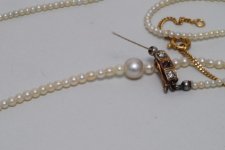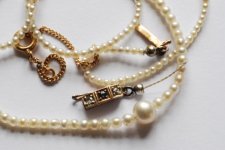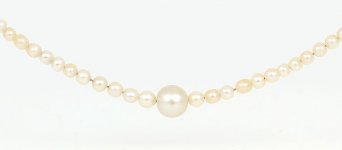You are using an out of date browser. It may not display this or other websites correctly.
You should upgrade or use an alternative browser.
You should upgrade or use an alternative browser.
Just bought...
- Thread starter Conny Forsberg
- Start date
lisa c
Perpetual Pearl Student
I think "show us more of it!" 
GemGeek
Pearlista
How about a natural light photo? 
CathyKeshi
Well-known member
"What do you think?" .... I think "WANT" 
Conny Forsberg
New Member
The pearls are not delivered yet but I will post more images when they arrive. It needs to be restrung as the silk is torn and some of the pearls are in a bag. For sure there will be a bunch of images shot. Pearls have to be cleaned and restrung for wife pretty soon.
GemGeek
Pearlista
That is wonderful. I will try to wait patiently. Looks great so far. 
AMc
McA
Interesting - I like the layout so far. Would love to know what they're strung on ...
Jacques
Pearly pearl
yes, was wondering that too.
Conny Forsberg
New Member
At last got hold of the purchase. It has been at my kid brothers olace for a few weeks. Orientals is an old expression here in Scandinavia to distinguish natural from cultured. The pearls are strung on silk. The silk is snapped and 11 pearls are in a separate bag (good objects for microscopy). No signs of nucleii under the microscope. Smallest pearl is 1.7 mm and the "centerpiece" is 5.64 mm. Anyone would like to chime in regarding the nature of the pearls? Possible naturals? Most of the pearls fluoresce greenish under LWUV which most cultured Akoyas do too.
A few images shot today.
First shot under UV shielded daylight fluorescent tubes on 25% grey.

Second and third under diffused daylight.


A few images shot today.
First shot under UV shielded daylight fluorescent tubes on 25% grey.

Second and third under diffused daylight.


Conny Forsberg
New Member
Second and third image shot on white background.
Conny Forsberg
New Member
No real conclusions but I have an hunch so I just have it restrung and call it cultured.
Did you look down the drill holes with a loupe? Or hold them up against a bright light? (Candle them?) With that size pearl a round nucleus might be visible. At any rate, they are very pretty and the clasp a great compliment. Thanks for sharing.
Sorry, I missed where you said you did look down the pearl and didn't see a nuclei. The value certainly is different between cultured and natural, so why would you want to call them cultured if they are naturals?
Sorry, I missed where you said you did look down the pearl and didn't see a nuclei. The value certainly is different between cultured and natural, so why would you want to call them cultured if they are naturals?
Conny Forsberg
New Member
There is nothing but a hunch right now. There can be seen no nucleus when candeling but I do not see any sighs of natural either. The naturals ought to be a bit more different types when light shines through. They seem just too devoid of "anything". Also the fluorescence is pretty even and green in all of the pearls. That is typical of akoyas in my experience. as it will not be resold but worn by wife and daughter it does not really matter. If called likely cultured I do not lie. It would be worse to assume natural when not sure. I will have it restrung and that will give me opportunity to examine more pearls under microscope. I have never seen a 1.7 mm cultured pearl. Has anyone seen one and in that case is it possible to se nucleus?
CathyKeshi
Well-known member
Well, Conny, whatever you call it, it's a lovely necklace ... and that clasp is fabulous!
Lagoon Island Pearls
Well-known member
- Joined
- Dec 8, 2009
- Messages
- 2,139
Drilled pearls are destroyed pearls from a scientific perspective. Much of the nuclear component is lost, making identification even more uncertain.
Interestingly enough though, by your description these are cultured pearls. "Devoid of anything" and "even and green" are disqualification points from the natural pearl side of the differential diagnosis. Likewise the absence of flame patterns demerit natural origin. Flame patterns are more typical in salt water pearls, hence these are likely fresh. Yet another demerit to natural origin, based upon the singular issue of availability (or lack of same).
Many strands, especially ones with no documentation or provenance claimed to be natural are not. Some are mixed strands. Many are elaborate fakes. Very, very few are unquestionably certifiable. Some are misunderstood through naivety, passed off as natural.
Like any pearl crafting, natural pieces are graded from pools of pearls. In almost every instance, compromises are made for the sake of inconsistencies. Symmetrical mismatching, as it were. Graduation by size, is technically that, as are color, surface and shape. Cultured pearls have eight grade points, naturals ten (add translucency and flame pattern). It's mathematically impossible to match a natural piece with the same scrutiny as cultured pieces... none more so than strands. Looking at this strand, it seems likely, nuclear clarity is co-incidental, as opposed to a point based in the selection criteria. Of thousands of natural pearls in my inventory, I'm often hard pressed to even find matched pairs. They truly are... like snow flakes.
Unless a natural strand is outrageously exceptional, the odds they'd have identical nuclei and florescence are astronomical.
Your hunch is reasonable. It's a beautiful strand, nonetheless.
Interestingly enough though, by your description these are cultured pearls. "Devoid of anything" and "even and green" are disqualification points from the natural pearl side of the differential diagnosis. Likewise the absence of flame patterns demerit natural origin. Flame patterns are more typical in salt water pearls, hence these are likely fresh. Yet another demerit to natural origin, based upon the singular issue of availability (or lack of same).
Many strands, especially ones with no documentation or provenance claimed to be natural are not. Some are mixed strands. Many are elaborate fakes. Very, very few are unquestionably certifiable. Some are misunderstood through naivety, passed off as natural.
Like any pearl crafting, natural pieces are graded from pools of pearls. In almost every instance, compromises are made for the sake of inconsistencies. Symmetrical mismatching, as it were. Graduation by size, is technically that, as are color, surface and shape. Cultured pearls have eight grade points, naturals ten (add translucency and flame pattern). It's mathematically impossible to match a natural piece with the same scrutiny as cultured pieces... none more so than strands. Looking at this strand, it seems likely, nuclear clarity is co-incidental, as opposed to a point based in the selection criteria. Of thousands of natural pearls in my inventory, I'm often hard pressed to even find matched pairs. They truly are... like snow flakes.
Unless a natural strand is outrageously exceptional, the odds they'd have identical nuclei and florescence are astronomical.
Your hunch is reasonable. It's a beautiful strand, nonetheless.
GemGeek
Pearlista
Beautiful -- and thoughtful of you to procure it for your ladies.  The smaller pearls will most likely be seed pearls or keshi and not have a nucleus.
The smaller pearls will most likely be seed pearls or keshi and not have a nucleus.
Similar threads
- Replies
- 9
- Views
- 943
- Replies
- 1
- Views
- 784
- Replies
- 26
- Views
- 6K

